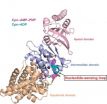(Press-News.org) CLEMSON — A study of X-rays emitted a long time ago in a galaxy far, far away has unmasked a stellar mass black hole in Andromeda, a spiral galaxy about 2.6 million light-years from Earth.
Two Clemson University researchers joined an an international team of astronomers, including scientists at Germany's Max Planck Institute for Extraterrestrial Physics, in publishing their findings in a pair of scientific journals this week.
Scientists had suspected the black hole was possible since late 2009 when an X-ray satellite observatory operated by the Max Planck Institute detected an unusual X-ray transient light source in Andromeda.
"The brightness suggested that these X-rays belonged to the class of ultraluminous X-ray sources, or ULXs," said Amanpreet Kaur, a Clemson graduate student in physics and lead author of the paper published in the Astronomy & Astrophysics Journal. "But ULXs are rare. There are none at all in the Milky Way where Earth is located, and this is the first to be confirmed in Andromeda. Proving it required detailed observations."
Because ULX sources are rare — usually with just one or two in a galaxy, if they are present at all — there was very little data with which astronomers could make conjectures.
"There were two competing explanations for their high luminosities," said Clemson physics professor Dieter Hartmann, Kaur's mentor and a co-author of the paper. "Either a stellar mass black hole was accreting at extreme rates or there was a new subspecies of intermediate mass black holes accreting at lower rates. One of the greatest difficulties in attempting to find the right answer is the large distance to these objects, which makes detailed observations difficult or even impossible."
Working with scientists in Germany and Spain, the Clemson researchers studied data from the Chandra observatory and proved that the X-ray source was a stellar mass black hole that is swallowing material at very high rates.
Follow-up observations with the Swift and HST satellites yielded important complementary data, proving that it not only is the first ULX in Andromeda but also the closest ULX ever observed. Despite its great distance away, Andromeda is actually the nearest major galactic neighbor to our own Milky Way.
"We were very lucky that we caught the ULX early enough to see most of its light curve, which showed a very similar behavior to other X-ray sources from our own galaxy," said Wolfgang Pietsch of the Max Planck Institute. The emission decayed exponentially with a characteristic timescale of about one month, which is a common property of stellar mass X-ray binaries. "This means that the ULX in Andromeda likely contains a normal, stellar black hole swallowing material at very high rates."
The emission of the ULX source, the scientists said, probably originates from a system similar to X-ray binaries in our own galaxy, but with matter accreting onto a black hole that is at least 13 times more massive than our Sun.
Unlike X-ray binaries in our own Milky Way, this source is much less obscured by interstellar gas and dust, allowing detailed investigations also at low X-ray energies.
Ideally, the astronomers would like to replicate their findings by re-observing the source in another outburst. However, if it is indeed similar to the X-ray binaries in our own Milky Way, they may be in for a long wait: Such outbursts can occur decades apart.
"On the other hand, as there are so many X-ray binaries in the Andromeda galaxy, another similar outbursting source could be captured any time by the ongoing monitoring campaign," Hartmann said. "While 'monitoring' may not sound exciting, the current results show that these programs are often blessed with discovery and lead to breakthroughs; in particular, if they are augmented with deep and sustained follow-up."
INFORMATION:
Astrophysicists from Clemson University and Europe unmask a black hole
2012-02-27
ELSE PRESS RELEASES FROM THIS DATE:
The emotional oracle effect
2012-02-27
NEW YORK – February 24, 2012 – A forthcoming article in the Journal of Consumer Research by Professor Michel Tuan Pham, Kravis Professor of Business, Marketing, Columbia Business School; Leonard Lee, Associate Professor, Marketing, Columbia Business School; and Andrew Stephen, PhD '09, currently Assistant Professor of Business Administration, Joseph M. Katz Graduate School of Business, University of Pittsburgh, finds that a higher trust in feelings may result in more accurate predictions about a variety of future events. The research will also be featured in Columbia Business ...
Correct protein folding
2012-02-27
The gold standard for nanotechnology is nature's own proteins. These biomolecular nanomachines – macromolecules forged from peptide chains of amino acids - are able to fold themselves into a dazzling multitude of shapes and forms that enable them to carry out an equally dazzling multitude of functions fundamental to life. As important as protein folding is to virtually all biological systems, the mechanisms behind this process have remained a mystery. The fog, however, is being lifted.
A team of researchers with the U.S. Department of Energy (DOE)'s Lawrence Berkeley ...
Statins linked with lower depression risk in heart patients
2012-02-27
Patients with heart disease who took cholesterol-lowering statins were significantly less likely to develop depression than those who did not, in a study by Mary Whooley, MD, a physician at the San Francisco VA Medical Center and a professor of medicine at the University of California, San Francisco.
The study was published electronically in the Journal of Clinical Psychiatry (February 21, 2012).
Whooley and her research team evaluated 965 heart disease patients for depression, and found that the patients who were on statins were significantly less likely to be clinically ...
Study proposes new measure of world equity market segmentation
2012-02-27
NEW YORK – February 24, 2012 – A recent study in the Review of Financial Studies proposes a new, valuation-based measure of equity market segmentation. Equity market segmentation occurs when stocks of similar risk in different countries are priced differently. The study, by Columbia Business School Professor Geert Bekaert, Chazen Senior Scholar at The Jerome A. Chazen Institute of International Business at Columbia Business School and the Leon G. Cooperman Professor of Finance and Economics, uncovers the factors that cause variation in market segmentation, both through ...
Rethinking the social structure of ancient Eurasian nomads: Current Anthropology research
2012-02-27
Prehistoric Eurasian nomads are commonly perceived as horse riding bandits who utilized their mobility and military skill to antagonize ancient civilizations such as the Chinese, Persians, and Greeks. Although some historical accounts may support this view, a new article by Dr. Michael Frachetti (Washington University, St. Louis) illustrates a considerably different image of prehistoric pastoralist societies and their impact on world civilizations more than 5000 years ago.
In the article, recently published in the February issue of Current Anthropology, Frachetti argues ...
New research points to erosional origin of linear dunes
2012-02-27
Boulder, Colorado, USA - Linear dunes, widespread on Earth and Saturn's moon, Titan, are generally considered to have been formed by deposits of windblown sand. It has been speculated for some time that some linear dunes may have formed by "wind-rift" erosion, but this model has commonly been rejected due to lack of sufficient evidence. Now, new research supported by China's NSF and published this week in GSA BULLETIN indicates that erosional origin models should not be ruled out.
The linear dunes in China's Qaidam Basin have been proposed to have formed as self-extending ...
GSA Bulletin: Alaska, Russia, Tibet, the Mississippi River, and the Great Green River Basin
2012-02-27
Boulder, CO, USA - New GSA BULLETIN science published online 24 Feb. includes work on the Chugach Metamorphic Complex of southern Alaska; news and data from the first non-Russian science team to make a helicopter over-flight of Shiveluch volcano in Kamchatka, Russia, after its large 2005 eruption; and a study by a team from the Lamont-Doherty Earth Observatory that proposes a new calibration model for the Eocene segment of the Geomagnetic Polarity Time Scale (GPTS).
Large-scale, short-lived metamorphism, deformation, and magmatism in the Chugach metamorphic complex, ...
Study shows significant state-by-state differences in black, white life expectancy
2012-02-27
A UCLA-led group of researchers tracing disparities in life expectancy between blacks and whites in the U.S. has found that white males live about seven years longer on average than African American men and that white women live more than five years longer than their black counterparts.
But when comparing life expectancy on a state-by-state basis, the researchers made a surprising discovery: In those states in which the disparities were smallest, the differences often were not the result of African Americans living longer but of whites dying younger than the national ...
Training parents is good medicine for children with autism behavior problems
2012-02-27
Children with autism spectrum disorders who also have serious behavioral problems responded better to medication combined with training for their parents than to treatment with medication alone, Yale researchers and their colleagues report in the February issue of Journal of the American Academy of Child & Adolescent Psychiatry.
"Serious behavioral problems interfere with everyday living for children and their families," said senior author on the study Lawrence Scahill, professor at Yale University School of Nursing and the Child Study Center. "Decreasing these serious ...
Study extends the 'ecology of fear' to fear of parasites
2012-02-27
Here's a riddle: What's the difference between a tick and a lion? The answer used to be that a tick is a parasite and the lion is a predator. But now those definitions don't seem as secure as they once did.
A tick also hunts its prey, following vapor trails of carbon dioxide, and consumes host tissues (blood is considered a tissue), so at least in terms of its interactions with other creatures, it is like a lion — a very small, eight-legged lion.
Ecologists are increasingly finding it useful to think of parasites, such as ticks, as micro-predators and have been mining ...



